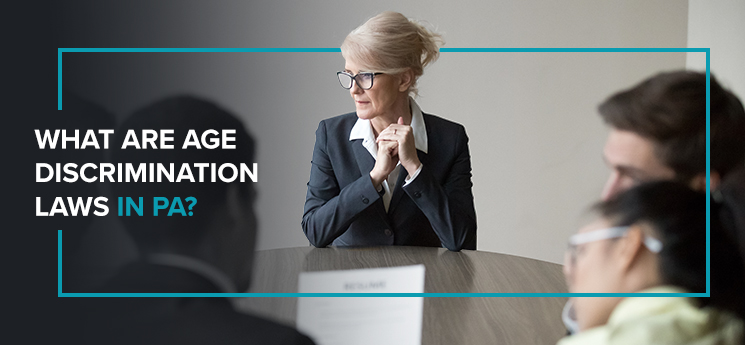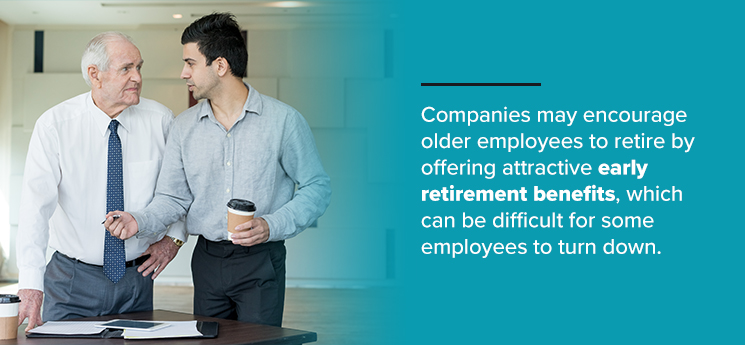Worldwide, age discrimination is a significant issue in the workplace. The United Nations (U.N.) and World Health Organization (WHO) Global Report on Ageism found that more than half of the people in the 57 countries surveyed expressed ageist attitudes. However, age discrimination harms the entire United States economy. A study from AARP found that employer ageism cost the U.S. economy $850 billion in 2018, the same size as Pennsylvania’s economy.
In Pennsylvania, nearly a quarter of all 2020 charge filings with the U.S. Equal Employment Opportunity Commission (EEOC) were age-related. Therefore, it’s crucial to treat your employees with respect and protect your company from lawsuits by learning to spot the signs of age discrimination in the workplace and understanding Pennsylvania age discrimination laws.
What Is Age Discrimination?
Workplace age discrimination happens when an employer discredits an employee’s ideas, passes them up for promotions or mistreats them because of their age. Often, age discrimination occurs in hiring and firing, during demotions, promotions or pay and because of a hostile workplace culture due to harassment.
Regardless of how it happens, age discrimination harms a person’s potential to have a successful career. Other negative impacts of age discrimination in the workplace include:
- Stress-related health effects
- Emotional harm, including feeling like they’re older than their actual age
- More extended periods of unemployment compared to younger age groups
- Financial consequences like using retirement funds
Ageism can happen to both young and old workers. For example, an employer may wrongly assume an older adult may not be as technologically savvy as a younger employee, especially considering access to specialized training typically decreases with age. On the other hand, employers could incorrectly think a young person is not capable or has less experience than their older co-workers.
Age discrimination also harms employers. Many skilled industries are currently experiencing a skills gap in which there is not enough skilled labor to fill the demand. Hiring older skilled workers offers one solution — these employees may have years of training and experience. Companies with many age discrimination complaints may also have to deal with increased costs due to lawsuits.
Examples of Discrimination Against Age
Age discrimination in the workplace can take several forms. If you feel like you or a co-worker is dealing with age discrimination, look out for the following signs:
- Receiving assignments under your skill level: Employers may make older workers feel less valued or essential by giving them fewer or less challenging assignments, excluding them from meetings or isolating their desks from the rest of their department.
- Being encouraged to retire: Companies may encourage older employees to retire by offering attractive early retirement benefits, which can be difficult for some employees to turn down. Even if an employee rejects the idea of retirement, a company could also potentially still fire them anyway.
- Eliminating your job position: A company might delete a job role before creating a new position with the same purpose. Employers could be practicing ageism if they fire an older employee by eliminating their position and then hiring a younger team member to complete the same tasks.
- Suddenly getting harsher performance reviews: Employees who suddenly start facing harsher discipline without due cause may be the target of age discrimination. If a team member has demonstrated consistently high performance, but their employer suddenly places them on an improvement performance plan, an employer could be looking to fire them unfairly.
Pennsylvania Age Discrimination Laws
Some states have laws specifying protection against ageism for workers of all ages. However, Pennsylvania follows federal legislation, only making age-based discrimination illegal for workers over 40. The primary national laws that governs age discrimination cases in Pennsylvania are the Age Discrimination in Employment Act (ADEA) and Pennsylvania Human Relations Act (PHRA).
Age Discrimination in Employment Act
Passed in 1967, the ADEA protects workers older than 40 years old from discrimination due to age when hired by government agencies or private companies with at least 20 employees. Additionally, the PHRA provides protection for workers in companies with at least 4 employees in Pennsylvania. People who have experienced age discrimination in the workplace have up to 300 days to file a Charge of Discrimination with the EEOC, while claims under the PHRA must be filed within 180 days. Under the law, companies may not retaliate against employees for filing an age discrimination complaint.
Before the act’s passing, the 1965 Wirtz Report evaluated ageism in the U.S. The study found that employers routinely discriminated against employers over 40, with half limiting employers with age limits. Therefore, the goal of the ADEA is to both prevent discrimination and change incorrect attitudes that correlate a worker’s ability with their age.
The ADEA prohibits ageism in the following situations:
- In job advertisements: Employers may not advertise age preferences in job notices except in certain circumstances when a job requires an employee of a particular age, called a bona fide occupational qualification (BFOQ).
- During candidate vetting: Although the ADEA does not explicitly prohibit employers from asking about an applicant’s age during the interview process, this may deter older or younger employees from applying for a job. Therefore, the government recommends only asking about age after hiring them and only if legally necessary.
- When deciding benefits: Older employees are entitled to the same benefits and pay as their younger counterparts, as dictated by the Older Workers Benefit Protection Act of 1990 (OWBPA). Older workers may fear age discrimination when applying to jobs because their benefits are often more expensive.
Age Discrimination Today
Although the ADEA has improved conditions for older workers, age discrimination still happens today. As baby boomers have aged, so has today’s workforce, with the number of workers older than 55 doubling in the last 25 years. However, more than 60% of older employees still report they have experienced or witnessed age discrimination.
Ageism is also more rampant in certain industries, with most older women working as teachers or secretaries and men working as delivery drivers, janitors or in agriculture. One study found that tech industry professionals found people older than 35 to be too old for the industry. Further, ageism disproportionately affects different demographics, with more than three-quarters of African American and Black workers reporting ageism compared to 59% of white workers.
To prevent ageism, employees and employers can recognize stereotypes, calling out incidents to actively reject harmful, incorrect beliefs about age. Talking about age discrimination can help foster a positive and inclusive company culture.
Get a Free Consultation
Proving an age discrimination case may prove to be difficult without help from a law professional. If you have been the target of age discrimination in the workplace, an attorney can help you get the compensation you deserve. The lawyers at Weisberg Cummings, P.C. have more than 40 years of combined experience to help workers in Pennsylvania.
Contact us today to request a free consultation, where we’ll review your case and go over your options.



